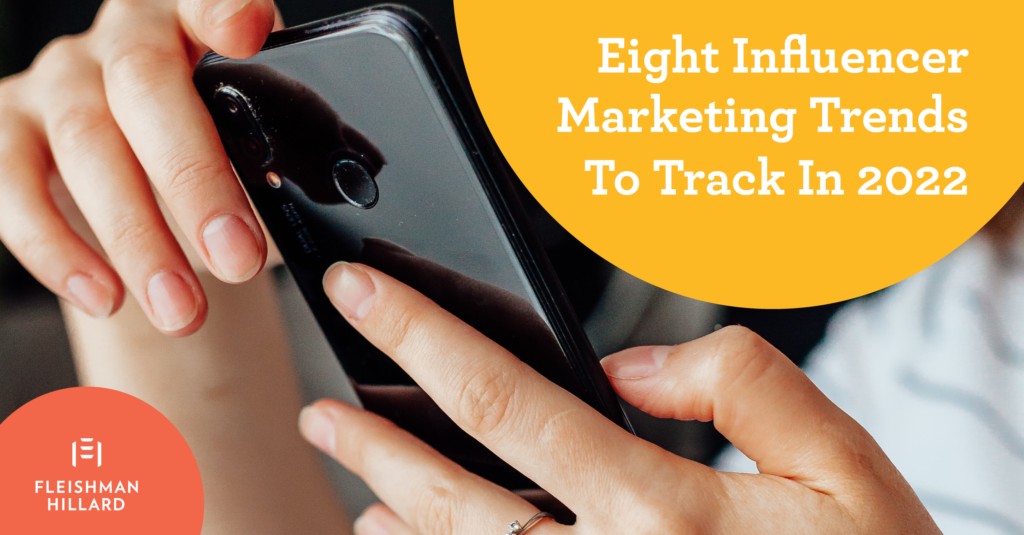Eight Influencer Marketing Trends to Track in 2022
As an industry, influencer marketing has expanded exponentially over the past few years. Worth just $1.7 billion in 2016, the industry is set to reach nearly $14 billion this year. Seventy-one percent of marketers plan to increase their budgets in the next 12 months, investing heavily in micro-influencers to target niche audiences.
How can organizations capitalize on this growth? Read on to see the influencer marketing trends we’re tracking in 2022.
Negotiation Opportunities When Working with Influencers
We know there is inequity in how influencers are compensated, particularly evident with influencers of color. This is not a new trend, but we are beginning to uncover the reasons behind this and see how people are working to address it. There is more work to do here – not only in terms of dollars but also in terms of brand opportunities for diverse influencers. In 2022, influencer marketing experts are predicted to be savvier negotiators, basing their worth beyond just “quoted rates.” Research shows influencers of color may undervalue their rates on projected value, which is determined by methodologies that factor quantitative and qualitative data to maintain objectivity. There will be a growth in understanding equity in terms of an appropriate value exchange but also in terms of influencer opportunities – not just in cash but also broader partnerships offered – maintaining an audience-first focus.
Subscription Services Driving Influencer Salary
Influencers have been diversifying their compensation models and aren’t reliant on one stream of income. Ad network revenue and affiliate marketing are becoming as lucrative and consistent as brand sponsorship deals.
But now, the trend is toward subscription services – not necessarily driving to a paywall but within social platforms where they’ve already built audiences. Instagram has launched a subscription service for users to pay for extra content from influencers in the platform. Superfans can decide to invest in up-leveled content from their favorite influencers. TikTok is also testing subscriptions for influencers and has already rolled out other ways to monetize content in the platform, such as tips from followers through the Creator Next program.
Currently, these options are only available to eligible influencers and come with a healthy dose of criticism from creators, so communicators should watch to see how it evolves this year.
Affiliate Links and Social Commerce are on the Rise
The industry is getting more strategic about using influencers to drive sales in-platform as opposed to driving to an e-commerce site. Brands are also incentivizing influencers to drive lead generation because consumers are not always ready to make an in-platform purchase and/or the client doesn’t sell online.
Influencer Behavior Poses a Risk to Brand Image
What happens when a brand is on contract with an influencer and the influencer does something or a post is resurfaced that goes against the brand’s values? In today’s “cancel culture,” it’s important to have clauses in influencer marketing contracts and to recognize the inherent risk with working with real people. Communicators must have a plan to address any unforeseen incidents. Additionally, be aware that if you’ve previously worked with an influencer that is deemed “canceled” by society for whatever reason, they may still be associated as an ambassador of the brand in the minds of consumers. Influencer vetting must go beyond quantitative data to the human element of evaluating brand safety and values alignment.
Paid Amplification is Even More Imperative to Reach Targeted Audiences
With platform algorithms deprioritizing sponsored content, there has never been a more important time for paid amplification. We have never equated influence to mass reach alone, but of course want as many people in our targeted audience to see the content we invested in influencers to create. Reach figures are pulled as part of the discovery phase, but communicators can’t rely on organic figures as performance metrics for sponsored content due to algorithms. Utilizing paid options is imperative in influencer marketing, period.
Influencer Marketing Growth in Regulated Industries
There are more opportunities for sectors like healthcare and financial communications, and we’re seeing the fastest growth in these highly-regulated industries. Understanding how to navigate and maintain influencer authenticity, creativity and collaboration given layers of content reviews is critical. Even in highly-regulated industries, influencer marketing doesn’t work if influencers are only regurgitating ad copy.
Influencers as Part of an Integrated Media Approach
Many influencers have larger audience sizes than traditional magazines and media websites. Influencers have been offered TV shows that they’ve turned down because they already have large, engaged audiences in the social spaces they’ve built, making more money than they would starring in a traditional TV show. Brands need to view influencers similar to media. They’ve worked to develop a loyal following in the spaces they own and in doing so, have developed themselves into a “media” outlet. Brands and communicators need to be think of influencers as “media” and journalists as “influencers” with an integrated marketing communications mindset.
Vertical Video Dominates Social Platforms
The cinematic horizontal format is no longer the default for professional creative. Vertical videos garner more impressions and views than horizontal videos. It’s the optimal format for navigating a device one-handed and thumb-swiping through videos in a visual platform. Think about the creative you’re asking of influencers, how it will be amplified across channels and how to use influencers as a brand’s initial way “in” to an owned TikTok channel or Instagram reels. Social video consumption is vertical today and we need to be collaborating with influencers to make that format work best. High production quality is not necessary.

